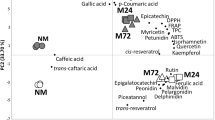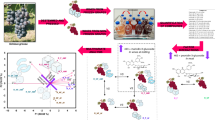Abstract
The effects of the maceration enzymes on the evolution of 4-vinylphenols pyranoanthocyanins and cinnamic acids were investigated during the Cabernet Gernischet red wine making. The results showed that the contents of p-coumaric acid and caffeic acid in the maceration enzyme-treated wine (the treated wine) were higher than those in the maceration enzyme-untreated wine (the control wine) at the alcoholic fermentation (AF), maceration (M), and malolactic fermention (MLF) stages. Malvidin-3-O-glucoside-4-vinylphenol (Mv-glu-vp) and malvidin-3-O-(6-O-acetyl)-glucoside-4-vinylphenol (Mvacet-glu-vp) were formed at the AF and M stages in the treated wine, while they were formed at the end of MLF stage in the control wine. However, the contents of these 2 kinds of 4-vinylphenol pyranoanthocyanins in the control wine were higher than those in the treated wine during aging. These results showed that the use of maceration enzymes in winemaking can promote p-coumaric acid and p-caffeic acid transformed to vinylphenols and accelerate the formation of pyranoanthocyanins.
Similar content being viewed by others
References
Pardo F, Salinas MR, Alonso GL, Navarro, G, Huertad MD. Effect of diverse enzyme preparations on the extraction and evolution of phenolic compounds in red wines. Food Chem. 67: 135–142 (1999)
Rogerson FSS, Vale E, Grande HJ, Silva MCM. Alternative processing of port-wine using pectolytic enzymes. Cienc. Tecnol. Aliment. 2: 222–227 (2000)
Parley A, Vanhanen L, Heatherbell D. The effect of prefermentation enzyme maceration on extraction and colour stability in Pinot noir wine. Aust. J. Grape Wine R. 7: 146–152 (2001)
Castro Vázquez L, Pérez-Coello MS, Cabezudo MD. Effects of enzyme treatment and skin extraction on varietal volatiles in Spanish wines made from Chardonnay, Muscat, Airen, and Macabeo grapes. Anal. Chim. Acta 458: 39–44 (2002)
Revilla I, González-SanJosé ML. Compositional changes during the storage of red wines treated with pectolytic enzymes: Low molecular-weight phenols and flavan-3-ol derivative levels. Food Chem. 80: 205–214 (2003)
Revilla I, González-SanJosé ML. Addition of pectolytic enzymes: An enological practice which improves the chromaticity and stability of red wines. Int. J. Food Sci. Tech. 38: 29–36 (2003)
Muñoz O, Sepúlveda M, Schwartz M. Effects of enzymatic treatment on anthocyanic pigments from grapes skin from chilean wine. Food Chem. 87: 487–490 (2004)
Bautista-Ortin AB, Martinez-Cutillas A, Ros-Garcia JM, López-Roca JM, Gómez-Plaza E. Improving colour extraction and stability in red wines: The use of maceration enzymes and enological tannins. Int. J. Food Sci. Tech. 40: 867–878 (2005)
Fulcrand H, Cameira dos Santos PJ, Sarni-Manchado P, Cheynier V, Favre-Bonvin J. Structure of new anthocyanin derived wine pigments. J. Chem. Soc. Perk. Trans. 17: 735–739 (1996)
Monagas M, Bartolome B, Gomez-Cordoves C. Updated knowledge about the presence of phenolic compounds in wine. Crit. Rev. Food Sci. 45: 85–118 (2005)
Alcalde-Eon C, Escribano-Bailón MT, Santos-Buelga C, Rivas-Gonzalo JC. Changes in the detailed pigment composition of red wine during maturity and ageing a comprehensive study. Anal. Chim. Acta 563: 238–254 (2006)
Mateus N, Oliveira J, Pissarra J, González-Paramás AM, Rivas-Gonzalo JC, Santos-Buelga C, Silva AMS, de Freitas V. A new vinylpyranoanthocyanin pigment occurring in aged red wine. Food Chem. 97: 689–695 (2006)
Bakker J, Timberlake CF. Isolation, identification, and characterization of new color-stable anthocyanins occurring in some red wines. J. Agr. Food Chem. 45: 35–43 (1997)
Morata A, Gómez-Cordovés MC, Calderón F, Suárez JA. Effects of pH, temperature and SO2 on the formation of pyranoanthocyanins during red wine fermentation with two species of Saccharomyces. Int. J. Food Microbiol. 106: 123–129 (2006)
Hayasaka Y, Asenstorfer RE. Screening for potential pigments derived from anthocyanins in red wine using nanoelectrospray tandem mass spectrometry. J. Agr. Food Chem. 50: 756–761 (2002)
Schwarz M, Winterhalter P. A novel synthetic route to substituted pyranoanthocyanins with unique colour properties. Tetrahedron Lett. 44: 7583–7587 (2003)
Schwarz M, Wabnitz TC, Winterhalter P. Pathway leading to the formation of anthocyanin-vinylphenol adducts and related pigments in red wines. J. Agr. Food Chem. 51: 3682–3687 (2003)
GarcÍa-Viguera C, Bridle P. Analysis of non-coloured phenolic compounds in red wine. A comparison of high-performance liquid chromatography and capillary zone electrophresis. Food Chem. 54: 349–352 (1995)
Chatonnet P, Dubourdieu D, Boidron JN, Lavigne V. Synthesis of volatile phenols by Saccharomyces cerevisiae in wines. J. Sci. Food Agr. 62: 191–202 (1993)
Somers CT, Verette E, Pocock KF. Hydroxycinnamate esters of vitis vinifera: Changes during white vinification, and effects of exogenous enzymic hydrolysis. J. Sci. Food Agr. 40: 67–78 (1987)
Dugelay I, Gunata Z, Sapis JC, Baumes R, Bayono C. Role of cinnamoyl esterase activities from enzyme preparations on the formation of volatile phenols during winemaking. J. Agr. Food Chem. 41: 2092–2096 (1993)
Gerbaux V, Vincent B, Bertrand A. Influence of maceration temperature and enzymes on the content of volatile phenols in Pinot noir wines. Am. J. Enol. Viticult. 53: 131–137 (2002)
Grimaldi A, Bartowsky E, Jiranek V. A survey of glycosidase activities of commercial wine strains of Oenococcus oeni. Int. J. Food Microbiol. 105: 233–244 (2005)
Liu S-Q. Malolactic fermentation in wine-beyond deacidification. J. Appl. Microbiol. 92: 589–601 (2002)
Chatonnet P, Dubourdieu D, Boidron JN, Lavigne V. The influence of Brettanomyces/Dekkera sp. yeasts and lactic acid bacteria on the ethylphenol content of red wines. Am. J. Enol. Viticult. 46: 463–468 (1995)
Chatonnet P, Viala C, Dubourdieu D. Influence of polyphenolic components of red wine on the microbial synthesis of volatile phenols. Am. J. Enol. Viticult. 48: 443–448 (1997)
Couto JA, Campos FM, Figueiredo AR, Hogg TA. Ability of lactic acid bacteria to produce volatile phenols. Am. J. Enol. Viticult. 57: 166–171 (2006)
Hernández T, Estrella I, Carlavilla D, Martín-álvarez PJ, Moreno-Arribas MV. Phenolic compounds in red wine subjected to industrial malolactic fermentation and ageing on lees. Anal. Chim. Acta 563: 116–125 (2006)
Schwarz M, Picazo-Bacete JJ, Winterhalter P, Hermosín-Gutiérrez I. Effect of copigments and grape cultivar on the color of red wines fermented after the addition of copigments. J. Agr. Food Chem. 53: 8372–8381 (2005)
Schwarz M, Hofmann G, Winterhalter P. Investigations on anthocyanins in wines from Vitis vinifera L. cv Pinotage: Factors influencing the formation of pinotin A and its correlation with wine age. J. Agr. Food Chem. 52: 498–504 (2004)
Author information
Authors and Affiliations
Corresponding author
Rights and permissions
About this article
Cite this article
He, JJ., Han, FL., Yu, QQ. et al. Effects of the maceration enzymes on evolution of pyranoanthocyanins and cinnamic acids during the cabernet gernischet (Vitis vinifera L. cv.) red wine making. Food Sci Biotechnol 19, 603–610 (2010). https://doi.org/10.1007/s10068-010-0085-z
Received:
Revised:
Accepted:
Published:
Issue Date:
DOI: https://doi.org/10.1007/s10068-010-0085-z




